Resolution Dependence of Regional Hydro-Climatic Projection: A Case-Study for the Johor River Basin, Malaysia
Abstract
1. Introduction
2. Materials and Methods
2.1. Study Area
2.2. Data
2.3. CMIP6 HighResMIP Models
2.4. Soil and Water Assessment Tool (SWAT)
3. Results
3.1. SWAT Sensitivity Analysis, Calibration and Validation
3.2. CMIP6 HighResMIP Models Evaluation and Bias Correction
3.3. Bias Corrected CMIP6 HighResMIP Future Projections
3.4. Hydrological Projections
4. Discussion
5. Conclusions
Author Contributions
Funding
Institutional Review Board Statement
Informed Consent Statement
Data Availability Statement
Acknowledgments
Conflicts of Interest
References
- Praskievicz, S.; Chang, H. A review of hydrological modelling of basin-scale climate change and urban development impacts. Prog. Phys. Geogr. Earth Environ. 2009, 33, 650–671. [Google Scholar] [CrossRef]
- Tan, M.L.; Gassman, P.; Yang, X.; Haywood, J. A Review of SWAT Applications, Performance and Future Needs for Simulation of Hydro-Climatic Extremes. Adv. Water Resour. 2020, 143, 103662. [Google Scholar] [CrossRef]
- Xu, C.-Y. Climate Change and Hydrologic Models: A Review of Existing Gaps and Recent Research Developments. Water Resour. Manag. 1999, 13, 369–382. [Google Scholar] [CrossRef]
- Phillips, N.A. The general circulation of the atmosphere: A numerical experiment. Q. J. R. Meteorol. Soc. 1956, 82, 123–164. [Google Scholar] [CrossRef]
- Weart, S. The development of general circulation models of climate. Stud. Hist. Philos. Sci. Part B Stud. Hist. Philos. Mod. Phys. 2010, 41, 208–217. [Google Scholar] [CrossRef]
- IPCC. Summary for Policymakers. In Climate Change 2021: The Physical Science Basis. Contribution of Working Group I to the Sixth Assessment Report of the Intergovernmental Panel on Climate Change; Masson-Delmotte, V., Zhai, P., Pirani, A., Connors, S.L., Péan, C., Berger, S., Caud, N., Chen, Y., Goldfarb, L., Gomis, M.I., et al., Eds.; IPCC: Geneva, Switzerland, 2021. [Google Scholar]
- Eyring, V.; Bony, S.; Meehl, G.A.; Senior, C.A.; Stevens, B.; Stouffer, R.J.; Taylor, K.E. Overview of the Coupled Model Intercomparison Project Phase 6 (CMIP6) experimental design and organization. Geosci. Model Dev. 2016, 9, 1937–1958. [Google Scholar] [CrossRef]
- Iqbal, Z.; Shahid, S.; Ahmed, K.; Ismail, T.; Ziarh, G.F.; Chung, E.-S.; Wang, X. Evaluation of CMIP6 GCM rainfall in mainland Southeast Asia. Atmos. Res. 2021, 254, 105525. [Google Scholar] [CrossRef]
- Van Vuuren, D.P.; Edmonds, J.; Kainuma, M.; Riahi, K.; Thomson, A.; Hibbard, K.; Hurtt, G.C.; Kram, T.; Krey, V.; Lamarque, J.-F.; et al. The representative concentration pathways: An overview. Clim. Chang. 2011, 109, 5. [Google Scholar] [CrossRef]
- Riahi, K.; van Vuuren, D.P.; Kriegler, E.; Edmonds, J.; O’Neill, B.C.; Fujimori, S.; Bauer, N.; Calvin, K.; Dellink, R.; Fricko, O.; et al. The Shared Socioeconomic Pathways and their energy, land use, and greenhouse gas emissions implications: An overview. Glob. Environ. Chang. 2017, 42, 153–168. [Google Scholar] [CrossRef]
- Eyring, V.; Cox, P.M.; Flato, G.M.; Gleckler, P.J.; Abramowitz, G.; Caldwell, P.; Collins, W.D.; Gier, B.K.; Hall, A.D.; Hoffman, F.M.; et al. Taking climate model evaluation to the next level. Nat. Clim. Chang. 2019, 9, 102–110. [Google Scholar] [CrossRef]
- Srivastava, A.; Grotjahn, R.; Ullrich, P.A. Evaluation of historical CMIP6 model simulations of extreme precipitation over contiguous US regions. Weather. Clim. Extrem. 2020, 29, 100268. [Google Scholar] [CrossRef]
- Su, B.; Huang, J.; Mondal, S.K.; Zhai, J.; Wang, Y.; Wen, S.; Gao, M.; Lv, Y.; Jiang, S.; Jiang, T.; et al. Insight from CMIP6 SSP-RCP scenarios for future drought characteristics in China. Atmos. Res. 2021, 250, 105375. [Google Scholar] [CrossRef]
- Syvitski, J.P.M.; Cohen, S.; Kettner, A.J.; Brakenridge, G.R. How important and different are tropical rivers?—An overview. Geomorphology 2014, 227, 5–17. [Google Scholar] [CrossRef]
- Jahandideh-Tehrani, M.; Zhang, H.; Helfer, F.; Yu, Y. Review of climate change impacts on predicted river streamflow in tropical rivers. Environ. Monit. Assess. 2019, 191, 752. [Google Scholar] [CrossRef]
- Awotwi, A.; Annor, T.; Anornu, G.K.; Quaye-Ballard, J.A.; Agyekum, J.; Ampadu, B.; Nti, I.K.; Gyampo, M.A.; Boakye, E. Climate change impact on streamflow in a tropical basin of Ghana, West Africa. J. Hydrol. Reg. Stud. 2021, 34, 100805. [Google Scholar] [CrossRef]
- Rodrigues, J.A.M.; Viola, M.R.; Alvarenga, L.A.; de Mello, C.R.; Chou, S.C.; de Oliveira, V.A.; Uddameri, V.; Morais, M.A.V. Climate change impacts under representative concentration pathway scenarios on streamflow and droughts of basins in the Brazilian Cerrado biome. Int. J. Climatol. 2020, 40, 2511–2526. [Google Scholar] [CrossRef]
- Tan, M.L.; Ibrahim, A.L.; Yusop, Z.; Chua, V.P.; Chan, N.W. Climate change impacts under CMIP5 RCP scenarios on water resources of the Kelantan River Basin, Malaysia. Atmos. Res. 2017, 189, 1–10. [Google Scholar] [CrossRef]
- Lebel, T.; Delclaux, F.; Le Barbé, L.; Polcher, J. From GCM scales to hydrological scales: Rainfall variability in West Africa. Stoch. Environ. Res. Risk Assess. 2000, 14, 275–295. [Google Scholar] [CrossRef]
- Tan, M.L.; Liang, J.; Samat, N.; Chan, N.W.; Haywood, J.M.; Hodges, K. Hydrological Extremes and Responses to Climate Change in the Kelantan River Basin, Malaysia, Based on the CMIP6 HighResMIP Experiments. Water 2021, 13, 1472. [Google Scholar] [CrossRef]
- Heng, H.H.; Pan, W.F.; Siaw, F.L.; Hii, C.P. Coastal and Estuary Reservoir: Case Studies for Johor River Basin. J. Civ. Eng. Sci. Technol. 2017, 8, 25–40. [Google Scholar] [CrossRef][Green Version]
- Bernama. Drought Hits Johor Dam, Water Rationing for 15,000 in Kota Tinggi. 2019. Available online: https://www.freemalaysiatoday.com/category/nation/2019/03/12/drought-hits-johor-dam-water-rationing-for-15000-in-kota-tinggi/ (accessed on 11 September 2021).
- Chuah, C.J.; Ho, B.H.; Chow, W.T.L. Trans-boundary variations of urban drought vulnerability and its impact on water resource management in Singapore and Johor, Malaysia. Environ. Res. Lett. 2018, 13, 074011. [Google Scholar] [CrossRef]
- Kia, M.B.; Pirasteh, S.; Pradhan, B.; Mahmud, A.R.; Sulaiman, W.N.A.; Moradi, A. An artificial neural network model for flood simulation using GIS: Johor River Basin, Malaysia. Environ. Earth Sci. 2012, 67, 251–264. [Google Scholar] [CrossRef]
- Tan, M.L.; Ficklin, D.; Ibrahim, A.L.; Yusop, Z. Impacts and uncertainties of climate change on streamflow of the Johor River Basin, Malaysia using a CMIP5 General Circulation Model ensemble. J. Water Clim. Chang. 2014, 5, 676–695. [Google Scholar] [CrossRef]
- Tan, M.L.; Juneng, L.; Tangang, F.T.; Chan, N.W.; Ngai, S.T. Future hydro-meteorological drought of the Johor River Basin, Malaysia, based on CORDEX-SEA projections. Hydrol. Sci. J. 2019, 64, 921–933. [Google Scholar] [CrossRef]
- Bressiani, D.A.; Gassman, P.W.; Fernandes, J.G.; Garbossa, L.H.P.; Srinivasan, R.; Bonumá, N.B.; Mendiondo, E.M. Review of Soil and Water Assessment Tool (SWAT) applications in Brazil: Challenges and prospects. Int. J. Agric. Biol. Eng. 2015, 8, 9–35. [Google Scholar] [CrossRef]
- Gassman, P.W.; Reyes, M.R.; Green, C.H.; Arnold, J.G. The Soil and Water Assessment Tool: Historical Development, Applications, and Future Research Directions. Trans. ASABE 2007, 50, 1211–1250. [Google Scholar] [CrossRef]
- Tan, M.L.; Gassman, P.W.; Srinivasan, R.; Arnold, J.G.; Yang, X. A Review of SWAT Studies in Southeast Asia: Applications, Challenges and Future Directions. Water 2019, 11, 914. [Google Scholar] [CrossRef]
- Tan, M.L.; Juneng, L.; Tangang, F.T.; Chung, J.X.; Radin Firdaus, R.B. Changes in Temperature Extremes and Their Relationship with ENSO in Malaysia from 1985 to 2018. Int. J. Climatol. 2021, 41, E2564–E2580. [Google Scholar] [CrossRef]
- Tan, M.L.; Ibrahim, A.L.; Yusop, Z.; Duan, Z.; Ling, L. Impacts of land-use and climate variability on hydrological components in the Johor River basin, Malaysia. Hydrol. Sci. J. 2015, 60, 873–889. [Google Scholar] [CrossRef]
- Heng, H.H.; Hii, C.P.; Siaw, F.L.; Pan, W.F. Reservoir Yield Analysis Using Multiple Variable Regression Screening Model and Its Comparison: A Study of 28 Water Supply Dams in Malaysia. J. Eng. Technol. Adv. 2018, 3, 35–74. [Google Scholar]
- Tan, M.L.; Chua, V.P.; Li, C.; Brindha, K. Spatiotemporal analysis of hydro-meteorological drought in the Johor River Basin, Malaysia. Theor. Appl. Climatol. 2019, 135, 825–837. [Google Scholar] [CrossRef]
- Arnold, J.; Moriasi, D.; Gassman, P.; Abbaspour, K.C.; White, M.; Srinivasan, R.; Santhi, C.; Harmel, R.D.; van Griensven, A.; Van Liew, M.; et al. SWAT: Model use, calibration, and validation. Trans. ASABE 2012, 55, 1491–1508. [Google Scholar] [CrossRef]
- Haarsma, R.J.; Roberts, M.J.; Vidale, P.L.; Senior, C.A.; Bellucci, A.; Bao, Q.; Chang, P.; Corti, S.; Fučkar, N.S.; Guemas, V.; et al. High Resolution Model Intercomparison Project (HighResMIP v1.0) for CMIP6. Geosci. Model Dev. 2016, 9, 4185–4208. [Google Scholar] [CrossRef]
- Murphy, J. An Evaluation of Statistical and Dynamical Techniques for Downscaling Local Climate. J. Clim. 1999, 12, 2256–2284. [Google Scholar] [CrossRef]
- Musie, M.; Sen, S.; Srivastava, P. Application of CORDEX-AFRICA and NEX-GDDP datasets for hydrologic projections under climate change in Lake Ziway sub-basin, Ethiopia. J. Hydrol. Reg. Stud. 2020, 31, 100721. [Google Scholar] [CrossRef]
- Pandey, V.P.; Dhaubanjar, S.; Bharati, L.; Thapa, B.R. Hydrological response of Chamelia watershed in Mahakali Basin to climate change. Sci. Total Environ. 2019, 650, 365–383. [Google Scholar] [CrossRef]
- Arnold, J.G.; Srinivasan, R.; Muttiah, R.S.; Williams, J.R. Large area hydrologic modeling and assessment part I: Model development. JAWRA J. Am. Water Resour. Assoc. 1998, 34, 73–89. [Google Scholar] [CrossRef]
- Krysanova, V.; White, M. Advances in water resources assessment with SWAT—An overview. Hydrol. Sci. J. 2015, 60, 771–783. [Google Scholar] [CrossRef]
- CARD. SWAT Literature Database for Peer-Reviewed Journal Articles; Center for Agricultural and Rural Development, Iowa State University: Ames, IA, USA; Available online: https://www.card.iastate.edu/swat_articles/ (accessed on 31 June 2021).
- Gassman, P.W.; Wang, Y. IJABE SWAT Special Issue: Innovative modeling solutions for water resource problems. Int. J. Agric. Biol. Eng. 2015, 8, 1–8. [Google Scholar] [CrossRef]
- Akhavan, S.; Abedi Koupaei, J.; Mousavi, S.F.; Abbaspour, K.; Afyuni, M.; Eslamian, S.S. Estimation of Blue Water and Green Water Using SWAT Model in Hamadan-Bahar Watershed. Water Soil Sci. 2010, 14, 9–23. [Google Scholar]
- Moriasi, D.N.; Gitau, M.W.; Pai, N.; Daggupati, P. Hydrologic and water quality models: Performance measures and evaluation criteria. Trans. ASABE 2015, 58, 1763–1785. [Google Scholar] [CrossRef]
- Kiesel, J.; Kakouei, K.; Guse, B.; Fohrer, N.; Jähnig, S.C. When is a hydrological model sufficiently calibrated to depict flow preferences of riverine species? Ecohydrology 2020, 13, e2193. [Google Scholar] [CrossRef]
- Radcliffe, D.E.; Mukundan, R. PRISM vs. CFSR Precipitation Data Effects on Calibration and Validation of SWAT Models. JAWRA J. Am. Water Resour. Assoc. 2017, 53, 89–100. [Google Scholar] [CrossRef]
- Gupta, H.V.; Kling, H.; Yilmaz, K.K.; Martinez, G.F. Decomposition of the mean squared error and NSE performance criteria: Implications for improving hydrological modelling. J. Hydrol. 2009, 377, 80–91. [Google Scholar] [CrossRef]
- Thiemig, V.; Rojas, R.; Zambrano-Bigiarini, M.; De Roo, A. Hydrological evaluation of satellite-based rainfall estimates over the Volta and Baro-Akobo Basin. J. Hydrol. 2013, 499, 324–338. [Google Scholar] [CrossRef]
- Kouchi, D.H.; Esmaili, K.; Faridhosseini, A.; Sanaeinejad, S.H.; Khalili, D.; Abbaspour, K.C. Sensitivity of Calibrated Parameters and Water Resource Estimates on Different Objective Functions and Optimization Algorithms. Water 2017, 9, 384. [Google Scholar] [CrossRef]
- Abbaspour, K.C.; Vejdani, M.; Haghighat, S. SWAT-CUP calibration and uncertainty programs for SWAT. In MODSIM07 International Congress on Modelling and Simulation “Land, Water and Environmental Management: Integrated Systems for Sustainability”, Christchurch, New Zealand, 10–13 December 2007; Modelling and Simulation Society of Australia and New Zealand: Sydney, Australia, 2007; Volume 364, pp. 1603–1609. [Google Scholar]
- Tan, M.L.; Samat, N.; Chan, N.W.; Roy, R. Hydro-Meteorological Assessment of Three GPM Satellite Precipitation Products in the Kelantan River Basin, Malaysia. Remote Sens. 2018, 10, 1011. [Google Scholar] [CrossRef]
- Zhang, D.; Tan, M.L.; Dawood, S.R.S.; Samat, N.; Chang, C.K.; Roy, R.; Tew, Y.L.; Mahamud, M.A. Comparison of NCEP-CFSR and CMADS for Hydrological Modelling Using SWAT in the Muda River Basin, Malaysia. Water 2020, 12, 3288. [Google Scholar] [CrossRef]
- Sharannya, T.M.; Al-Ansari, N.; Deb Barma, S.; Mahesha, A. Evaluation of Satellite Precipitation Products in Simulating Streamflow in a Humid Tropical Catchment of India Using a Semi-Distributed Hydrological Model. Water 2020, 12, 2400. [Google Scholar] [CrossRef]
- Yesuf, H.M.; Melesse, A.M.; Zeleke, G.; Alamirew, T. Streamflow prediction uncertainty analysis and verification of SWAT model in a tropical watershed. Environ. Earth Sci. 2016, 75, 806. [Google Scholar] [CrossRef]
- Neitsch, S.L.; Arnold, J.G.; Kiniry, J.R.; Grassland, J.R.W. Soil and Water Assessment Tool Theoretical Documentation Version 2009; Agricultural Research Service Blackland Research Center: Temple, TX, USA, 2011. [Google Scholar]
- Moriasi, D.N.; Arnold, J.G.; Van Liew, M.W.; Bingner, R.L.; Harmel, R.D.; Veith, T.L. Model Evaluation Guidelines for Systematic Quantification of Accuracy in Watershed Simulations. Trans. ASABE 2007, 50, 885–900. [Google Scholar] [CrossRef]
- Liang, J.; Catto, J.L.; Hawcroft, M.; Hodges, K.I.; Tan, M.L.; Haywood, J.M. Climatology of Borneo Vortices in the HadGEM3-GC3.1 General Circulation Model. J. Clim. 2021, 34, 3401–3419. [Google Scholar] [CrossRef]
- Squintu, A.A.; van der Schrier, G.; van den Besselaar, E.; van der Linden, E.; Putrasahan, D.; Roberts, C.; Roberts, M.; Scoccimarro, E.; Senan, R.; Klein Tank, A. Evaluation of trends in extreme temperatures simulated by HighResMIP models across Europe. Clim. Dyn. 2021, 56, 2389–2412. [Google Scholar] [CrossRef]
- Kaur, M. Unusual to Have Floods in Johor Now, Says Weather Expert. 2020. Available online: https://www.freemalaysiatoday.com/category/nation/2020/06/21/unusual-to-have-floods-in-johor-now-says-weather-expert/ (accessed on 15 September 2021).
- Hu, J.; Ma, J.; Nie, C.; Xue, L.; Zhang, Y.; Ni, F.; Deng, Y.; Liu, J.; Zhou, D.; Li, L.; et al. Attribution Analysis of Runoff Change in Min-Tuo River Basin based on SWAT model simulations, China. Sci. Rep. 2020, 10, 2900. [Google Scholar] [CrossRef]
- Kim, H.; Parajuli, P.B. Impacts of Reservoir Outflow Estimation Methods in SWAT Model Calibration. Trans. ASABE 2014, 57, 1029–1042. [Google Scholar] [CrossRef]
- Wu, J.; Yen, H.; Arnold, J.G.; Yang, Y.C.E.; Cai, X.; White, M.J.; Santhi, C.; Miao, C.; Srinivasan, R. Development of reservoir operation functions in SWAT+ for national environmental assessments. J. Hydrol. 2020, 583, 124556. [Google Scholar] [CrossRef]
- Knoben, W.J.M.; Freer, J.E.; Woods, R.A. Technical note: Inherent benchmark or not? Comparing Nash–Sutcliffe and Kling–Gupta efficiency scores. Hydrol. Earth Syst. Sci. 2019, 23, 4323–4331. [Google Scholar] [CrossRef]
- Adeyeri, O.E.; Laux, P.; Arnault, J.; Lawin, A.E.; Kunstmann, H. Conceptual hydrological model calibration using multi-objective optimization techniques over the transboundary Komadugu-Yobe basin, Lake Chad Area, West Africa. J. Hydrol. Reg. Stud. 2020, 27, 100655. [Google Scholar] [CrossRef]
- Kamruzzaman, M.; Shahid, S.; Islam, A.R.M.T.; Hwang, S.; Cho, J.; Zaman, M.A.U.; Ahmed, M.; Rahman, M.M.; Hossain, M.B. Comparison of CMIP6 and CMIP5 model performance in simulating historical precipitation and temperature in Bangladesh: A preliminary study. Theor. Appl. Climatol. 2021, 145, 1385–1406. [Google Scholar] [CrossRef]
- Gosling, S.N.; Taylor, R.G.; Arnell, N.W.; Todd, M.C. A comparative analysis of projected impacts of climate change on river runoff from global and catchment-scale hydrological models. Hydrol. Earth Syst. Sci. 2011, 15, 279–294. [Google Scholar] [CrossRef]
- Hattermann, F.F.; Vetter, T.; Breuer, L.; Su, B.; Daggupati, P.; Donnelly, C.; Fekete, B.; Flörke, F.; Gosling, S.N.; Hoffmann, P.; et al. Sources of uncertainty in hydrological climate impact assessment: A cross-scale study. Environ. Res. Lett. 2018, 13, 015006. [Google Scholar] [CrossRef]
- Her, Y.; Yoo, S.-H.; Cho, J.; Hwang, S.; Jeong, J.; Seong, C. Uncertainty in hydrological analysis of climate change: Multi-parameter vs. multi-GCM ensemble predictions. Sci. Rep. 2019, 9, 4974. [Google Scholar] [CrossRef] [PubMed]
- Teng, J.; Vaze, J.; Chiew, F.H.S.; Wang, B.; Perraud, J.-M. Estimating the Relative Uncertainties Sourced from GCMs and Hydrological Models in Modeling Climate Change Impact on Runoff. J. Hydrometeorol. 2012, 13, 122–139. [Google Scholar] [CrossRef]
- IPCC. Global Warming of 1.5 °C. An IPCC Special Report on the Impacts of Global Warming of 1.5°C above Pre-Industrial Levels and Related Global Greenhouse Gas Emission Pathways, In the Context of Strengthening the Global Response to the Threat of Climate Change, Sustainable Development, and Efforts to Eradicate Poverty; IPCC: Geneva, Switzerland, 2018. [Google Scholar]
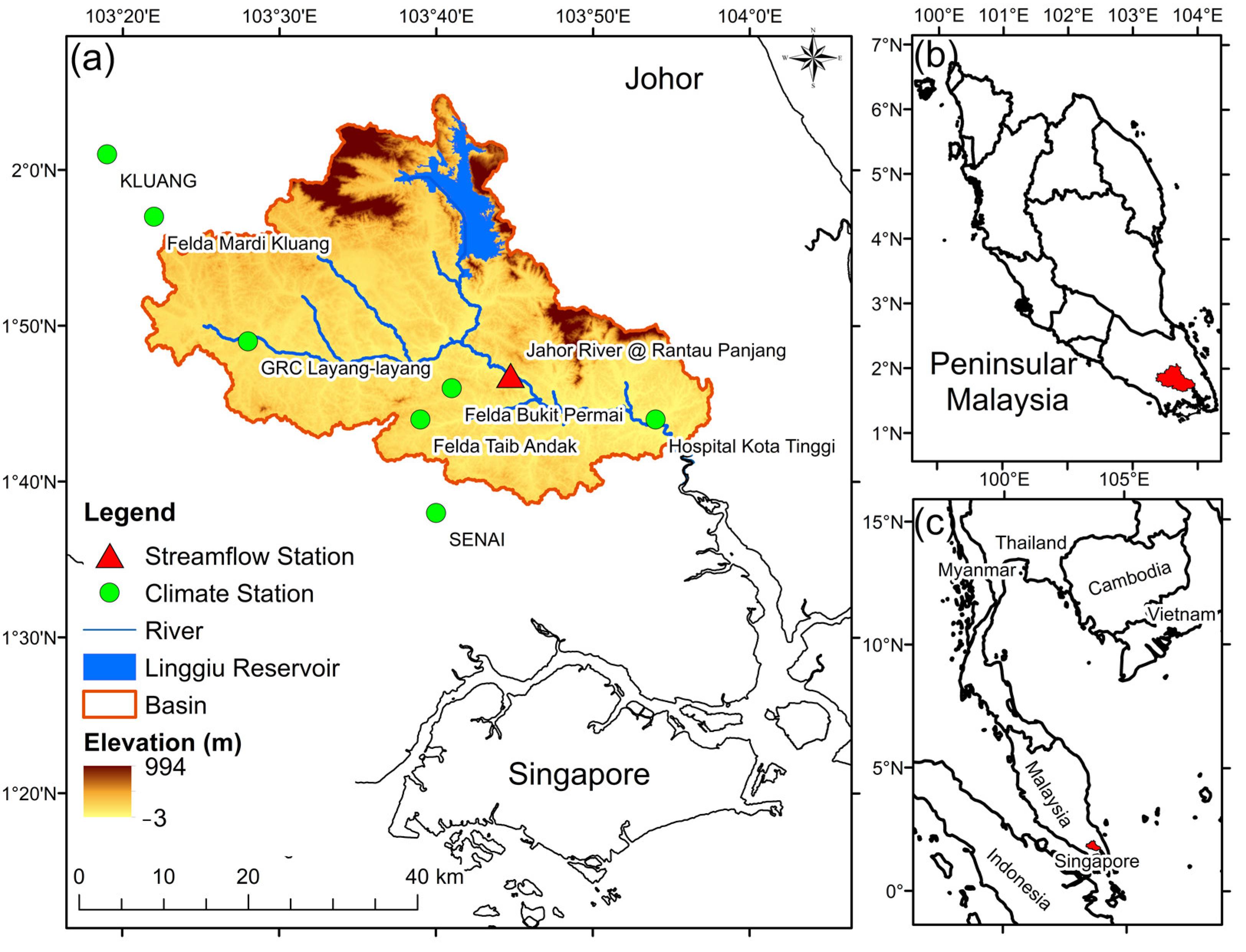
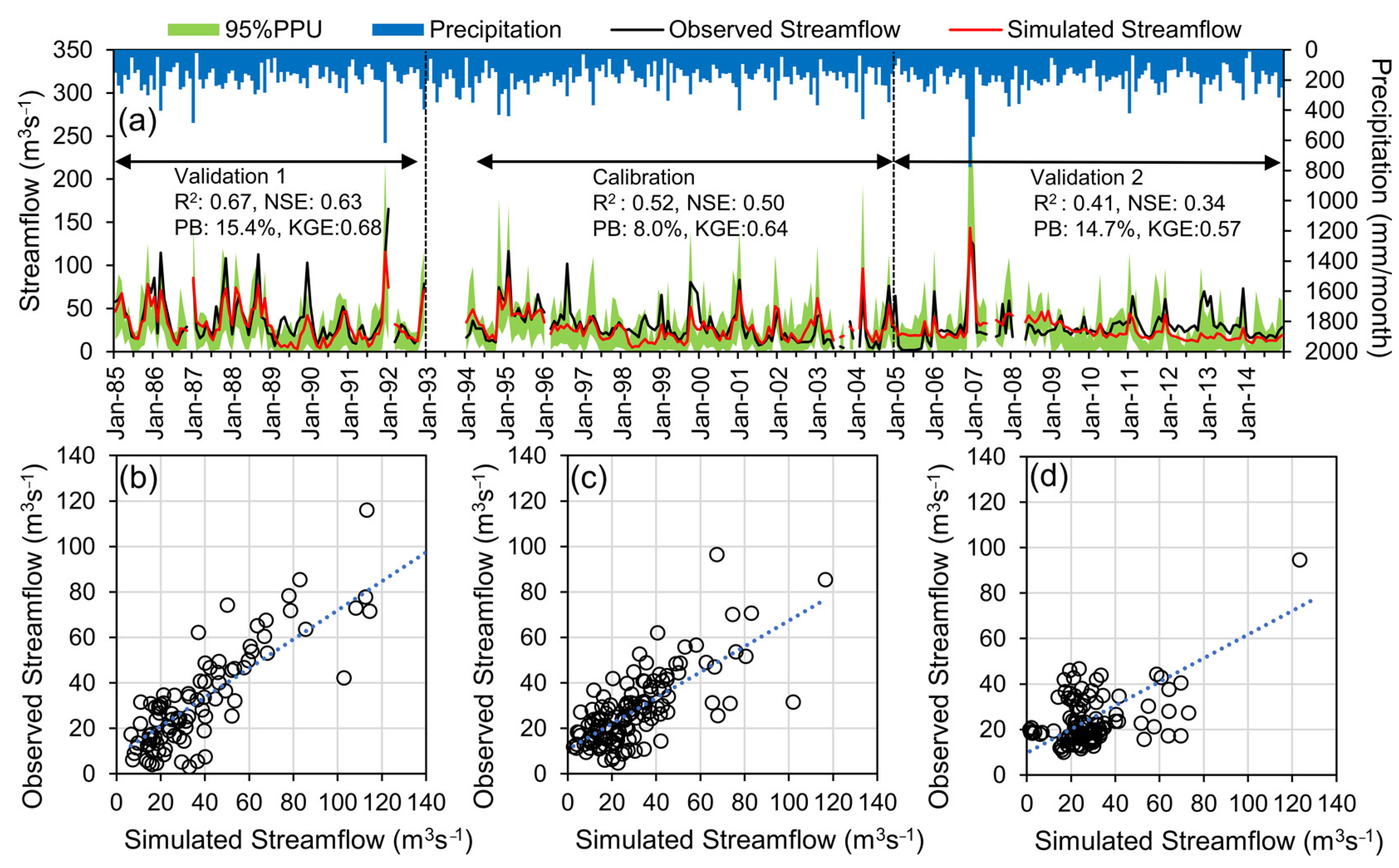
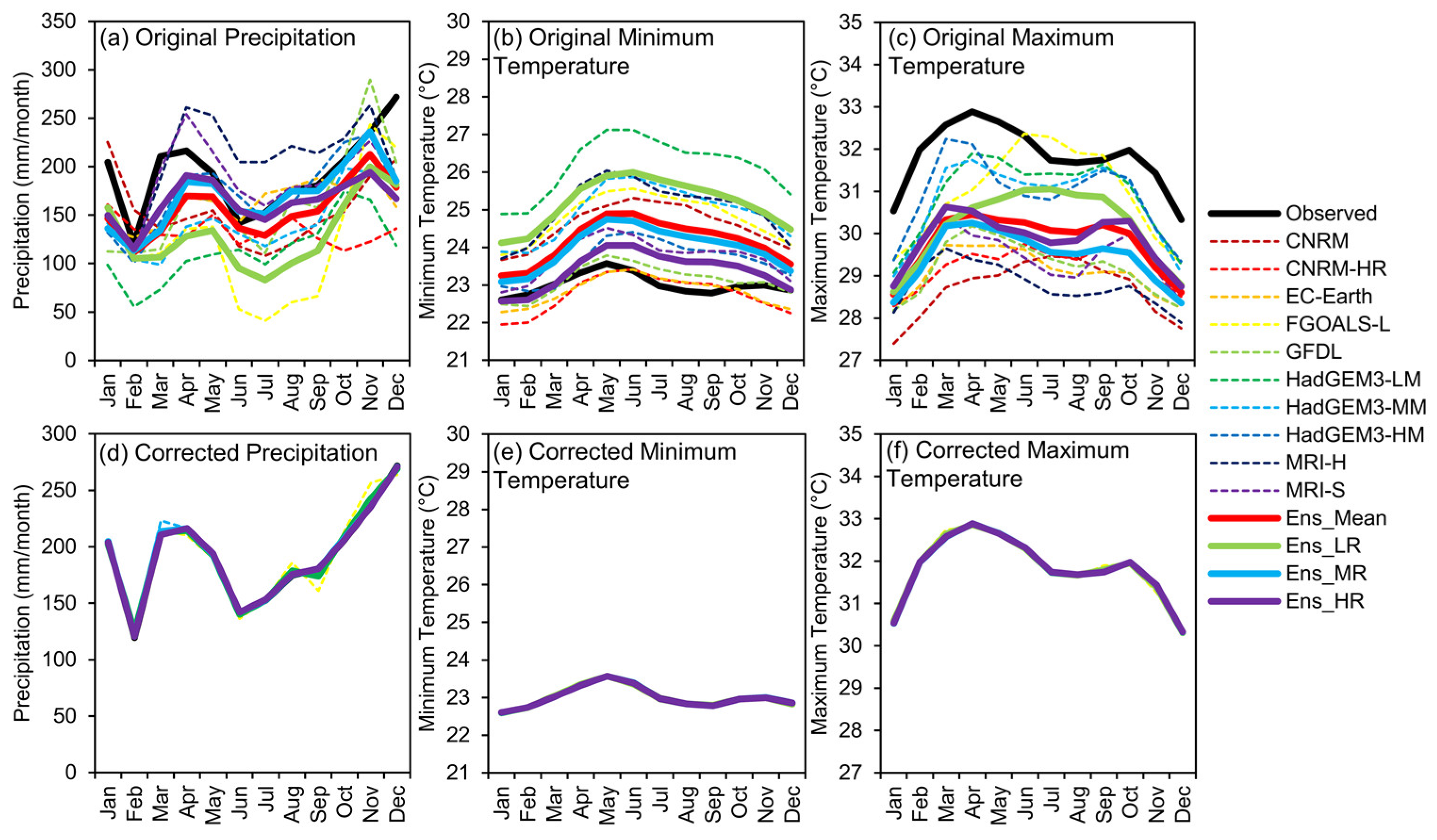
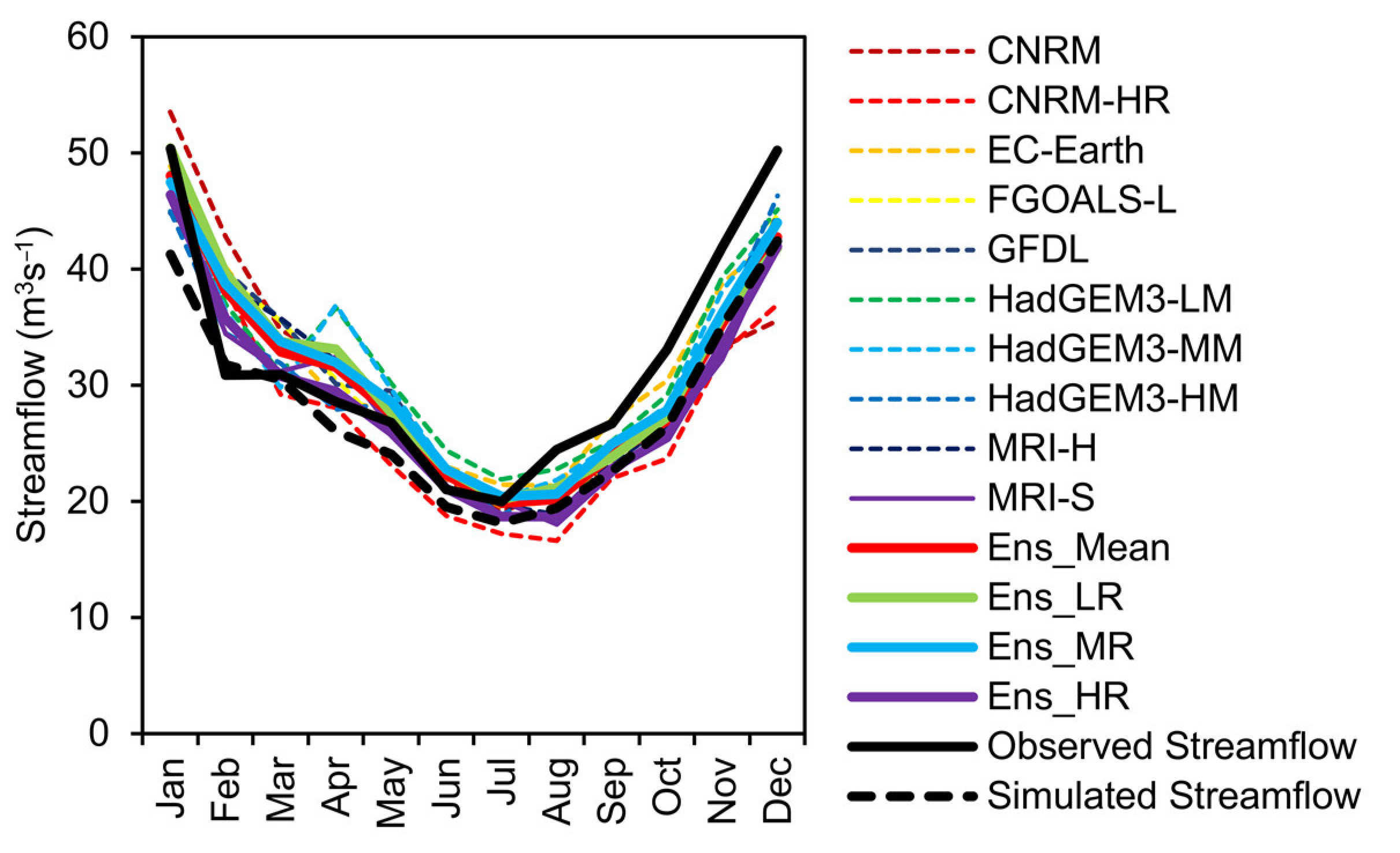
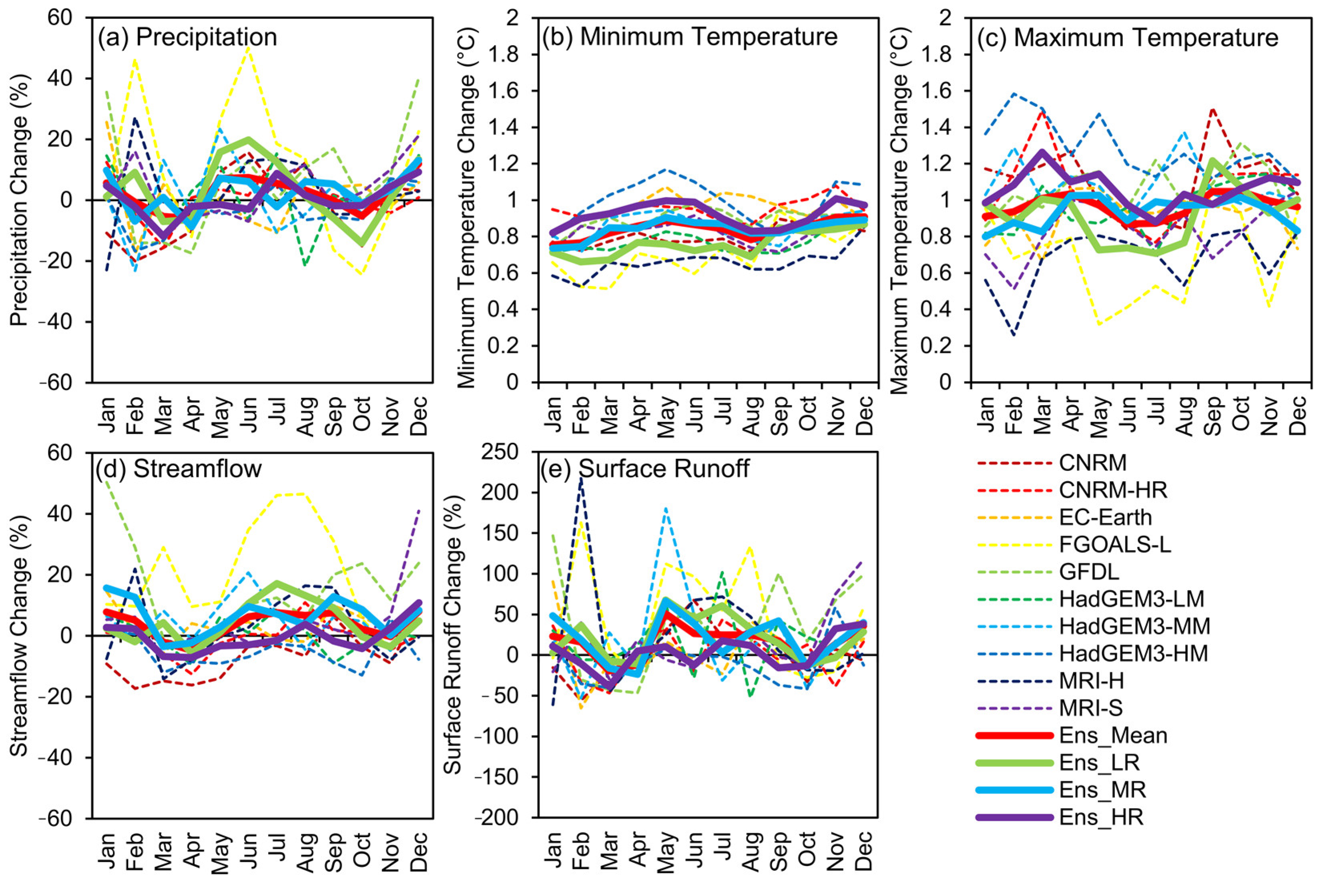
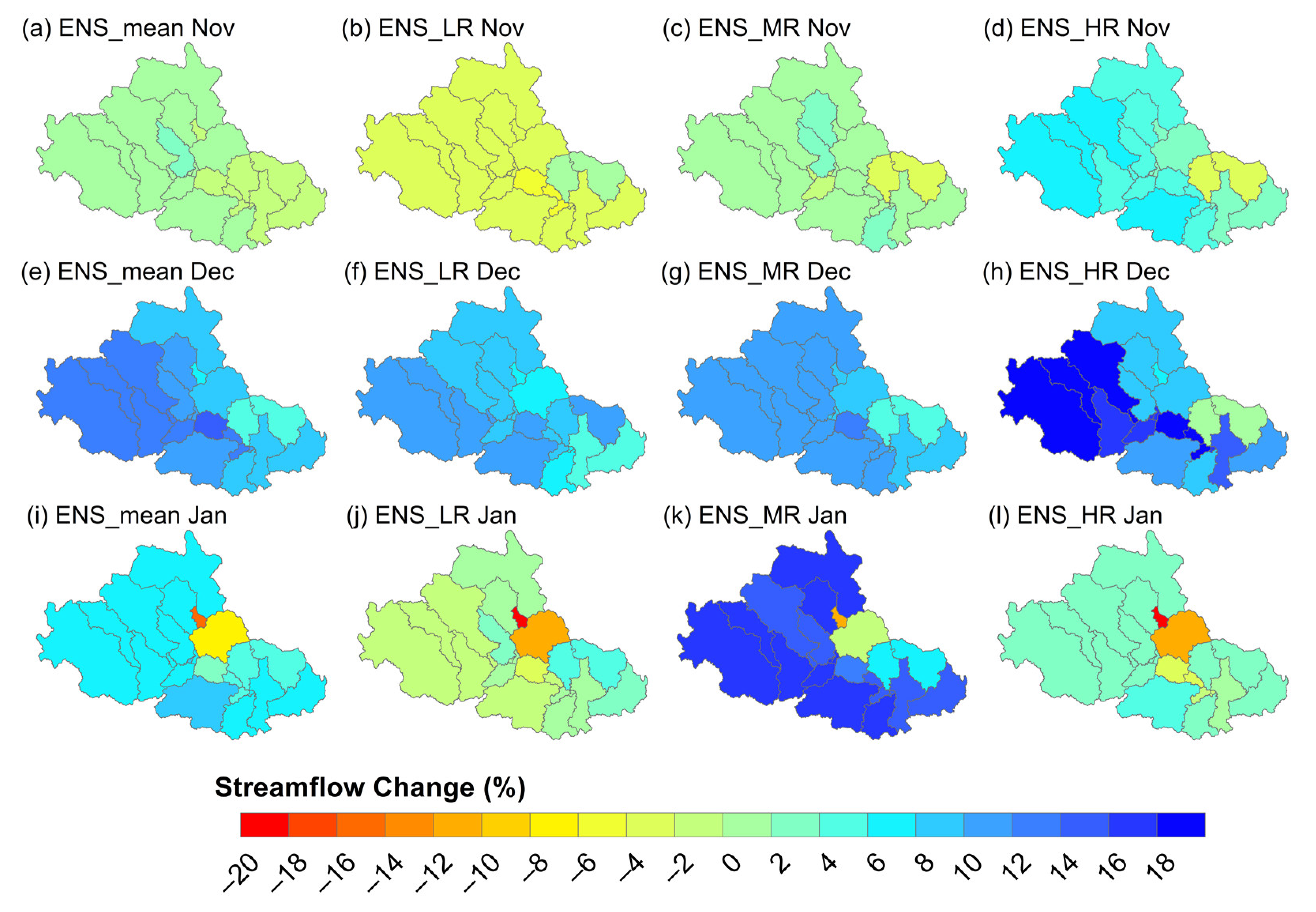
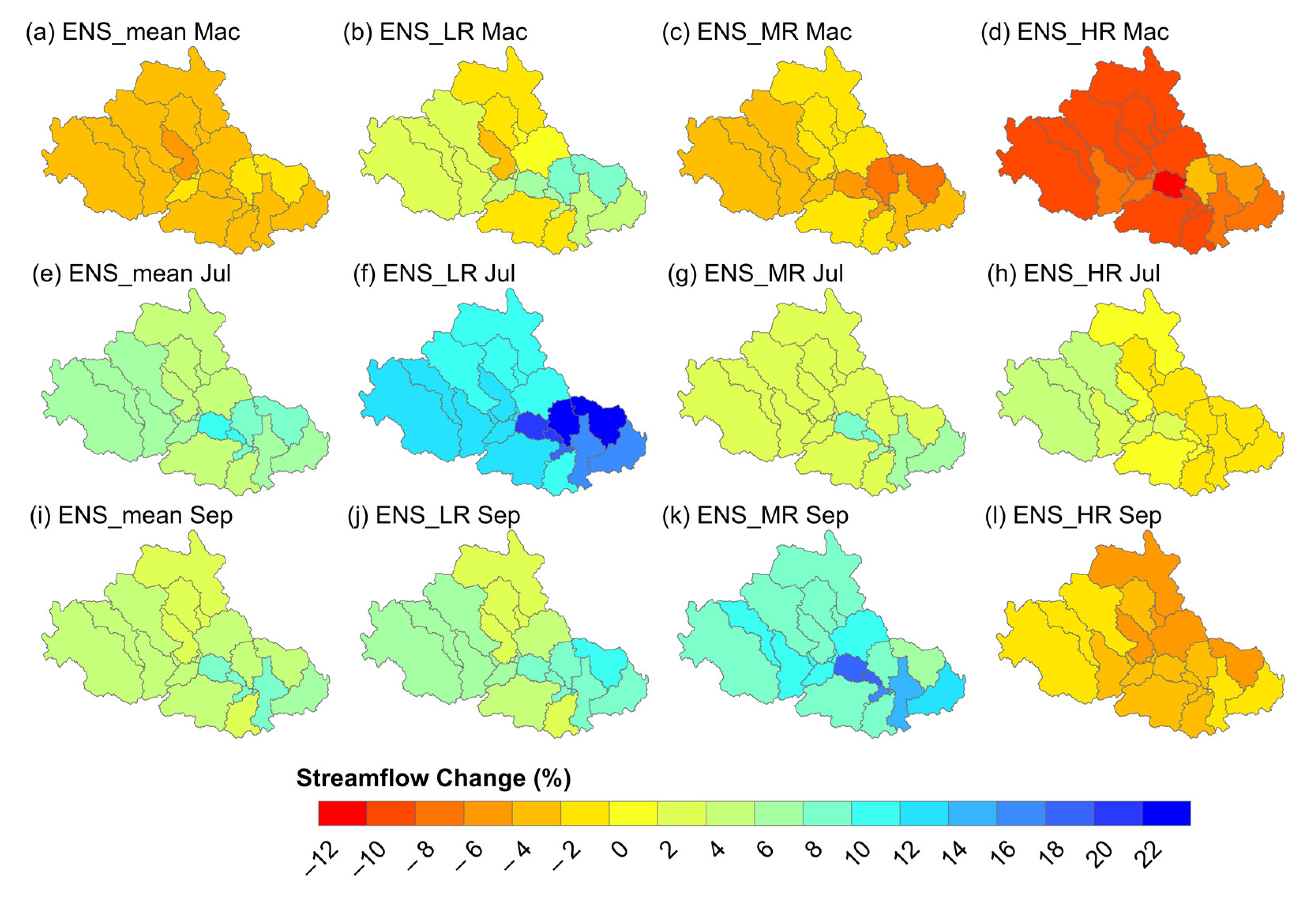
| No | Symbol | Model | Resolution (Longitude × Latitude) | Organization |
|---|---|---|---|---|
| 1 | CNRM | CNRM-CM6-1 | LR—1.406° × 1.406° | French National Centre for Meteorological Research |
| 2 | CNRM-HR | HR—0.5° × 0.5° | ||
| 3 | EC-Earth | EC-Earth3P | MR—0.703° × 0.703° | 27 institutes in Europe |
| 4 | FGOALS-L | FGOALS-f3 | LR—1.25° × 1° | Institute of Atmospheric Physics/Chinese Academy of Sciences |
| 5 | GFDL | GFDL-CM4C192 | MR—0.625° × 0.5° | Geophysical Fluid Dynamics Laboratory/NOAA (U.S.) |
| 6 | HadGEM3-LM | HadGEM3-GC31 | LR—1.875° × 1.25° | The UK Met Office Hadley Centre for Climate Change |
| 7 | HadGEM3-MM | MR—0.83° × 0.56° | ||
| 8 | HadGEM3-HM | HR—0.35° × 0.23° | ||
| 9 | MRI-H | MRI-AGCM3-2 | MR—0.563° × 0.563° | Meteorological Research Institute (Japan) |
| 10 | MRI-S | HR—0.188° × 0.188° |
| Method | Very Good | Good | Satisfactory | Not Satisfactory |
|---|---|---|---|---|
| R2 | >0.85 | 0.75 < R2 ≤ 0.85 | 0.60 < R2 ≤ 0.75 | ≤0.60 |
| NSE | >0.80 | 0.65 < NSE ≤ 0.80 | 0.50 < NSE ≤ 0.70 | ≤0.50 |
| RB (%) | >±5.00 | ±5.00 < RB ≤ ±10.00 | ±10.00 < RB ≤ ±15.00 | ≥±15.00 |
| KGE | >0.90 | 0.75 ≤ R2 < 0.90 | 0.50 ≤ R2 < 0.75 | <0.50 |
| No | Parameter | Name | Optimal | Min | Max |
|---|---|---|---|---|---|
| 1 | R__CN2.mgt | Initial SCS CN II value | −0.31 | −0.5 | 0.5 |
| 2 | V__ESCO.hru | Soil evaporation compensation factor | 0.96 | 0 | 1 |
| 3 | V__CH_N2.rte | Manning’s n for main channel | 0.28 | 0 | 0.3 |
| 4 | V__CANMX.hru | Maximum canopy storage | 6.92 | 0 | 10 |
| 5 | V__GW_REVAP.gw | Groundwater “revap” coefficient | 0.18 | 0.02 | 0.2 |
| 6 | R__SOL_Z(..).sol | Depth from soil surface to bottom of layer | −0.30 | −0.5 | 0.5 |
| 7 | V__GW_DELAY.gw | Groundwater delay | 120.38 | 0 | 500 |
| 8 | R__SOL_AWC(..).sol | Available water capacity | −0.50 | −0.5 | 0.5 |
| 9 | V__OFLOWMX(..).res | Maximum daily outflow for the month | 1835.50 | 0 | 2000 |
| 10 | R__SLSUBBSN.hru | Average slope length | −0.46 | −0.5 | 0.5 |
| 11 | R__SOL_K(..).sol | Saturated hydraulic conductivity | 0.50 | −0.5 | 0.5 |
| 12 | V__RCHRG_DP.gw | Deep aquifer percolation fraction | 0.31 | 0 | 1 |
| 13 | R__SOL_BD(..).sol | Moist bulk density | 0.03 | −0.5 | 0.5 |
| 14 | V__OFLOWMN(..).res | Minimum daily outflow for the month | 36.75 | 0 | 1000 |
| 15 | R__HRU_SLP.hru | Average slope steepness | −0.24 | −0.5 | 0.5 |
| Type | Symbol | Precipitation (%) | Minimum Temperature (°C) | Maximum Temperature (°C) | Streamflow (%) | Surface Runoff (%) |
|---|---|---|---|---|---|---|
| Ens_Mean | 2.1 | 0.8 | 1.0 | 4.1 | 15.2 | |
| Ens_LR | 2.4 | 0.8 | 0.9 | 3.1 | 15.6 | |
| Ens_MR | 3.1 | 0.8 | 0.9 | 7.0 | 20.6 | |
| Ens_HR | 0.4 | 0.9 | 1.1 | 0.9 | 7.0 | |
| LR | CNRM | −2.7 | 0.8 | 1.1 | −10.7 | −5.8 |
| HR | CNRM-HR | 0.4 | 1.0 | 1.1 | −1.3 | 1.9 |
| MR | EC-Earth | 1.5 | 1.0 | 0.9 | 2.7 | 10.6 |
| LR | FGOALS-L | 8.3 | 0.7 | 0.7 | 19.3 | 31.6 |
| MR | GFDL | 7.8 | 0.9 | 1.1 | 18.8 | 47.7 |
| LR | HadGEM3-LM | 1.5 | 0.8 | 1.0 | 0.8 | 20.4 |
| MR | HadGEM3-MM | 1.9 | 0.9 | 1.1 | 5.6 | 20.4 |
| HR | HadGEM3-HM | −2.7 | 1.0 | 1.3 | −5.6 | −6.8 |
| MR | MRI-H | 1.2 | 0.7 | 0.7 | 0.9 | 5.0 |
| HR | MRI-S | 3.6 | 0.8 | 0.8 | 9.7 | 26.2 |
Publisher’s Note: MDPI stays neutral with regard to jurisdictional claims in published maps and institutional affiliations. |
© 2021 by the authors. Licensee MDPI, Basel, Switzerland. This article is an open access article distributed under the terms and conditions of the Creative Commons Attribution (CC BY) license (https://creativecommons.org/licenses/by/4.0/).
Share and Cite
Tan, M.L.; Liang, J.; Hawcroft, M.; Haywood, J.M.; Zhang, F.; Rainis, R.; Ismail, W.R. Resolution Dependence of Regional Hydro-Climatic Projection: A Case-Study for the Johor River Basin, Malaysia. Water 2021, 13, 3158. https://doi.org/10.3390/w13223158
Tan ML, Liang J, Hawcroft M, Haywood JM, Zhang F, Rainis R, Ismail WR. Resolution Dependence of Regional Hydro-Climatic Projection: A Case-Study for the Johor River Basin, Malaysia. Water. 2021; 13(22):3158. https://doi.org/10.3390/w13223158
Chicago/Turabian StyleTan, Mou Leong, Ju Liang, Matthew Hawcroft, James M. Haywood, Fei Zhang, Ruslan Rainis, and Wan Ruslan Ismail. 2021. "Resolution Dependence of Regional Hydro-Climatic Projection: A Case-Study for the Johor River Basin, Malaysia" Water 13, no. 22: 3158. https://doi.org/10.3390/w13223158
APA StyleTan, M. L., Liang, J., Hawcroft, M., Haywood, J. M., Zhang, F., Rainis, R., & Ismail, W. R. (2021). Resolution Dependence of Regional Hydro-Climatic Projection: A Case-Study for the Johor River Basin, Malaysia. Water, 13(22), 3158. https://doi.org/10.3390/w13223158








